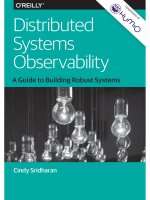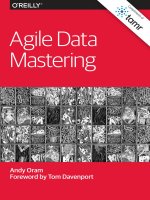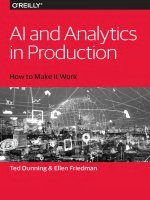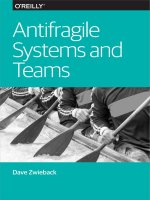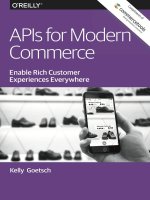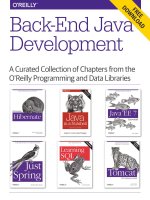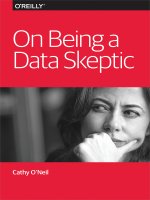IT training OReilly understanding experimentation platforms khotailieu
Bạn đang xem bản rút gọn của tài liệu. Xem và tải ngay bản đầy đủ của tài liệu tại đây (2.23 MB, 38 trang )
Co
m
pl
im
en
ts
of
Understanding
Experimentation
Platforms
Drive Smarter Product Decisions Through
Online Controlled Experiments
Adil Aijaz, Trevor Stuart
& Henry Jewkes
Understanding
Experimentation Platforms
Drive Smarter Product
Decisions Through Online
Controlled Experiments
Adil Ajiaz, Trevor Stuart, and Henry Jewkes
Beijing
Boston Farnham Sebastopol
Tokyo
Understanding Experimentation Platforms
by Adil Aijaz, Trevor Stuart, and Henry Jewkes
Copyright © 2018 O’Reilly Media. All rights reserved.
Printed in the United States of America.
Published by O’Reilly Media, Inc., 1005 Gravenstein Highway North, Sebastopol, CA
95472.
O’Reilly books may be purchased for educational, business, or sales promotional use.
Online editions are also available for most titles ( For more
information, contact our corporate/institutional sales department: 800-998-9938
or
Editor: Brian Foster
Production Editor: Justin Billing
Copyeditor: Octal Publishing, Inc.
Proofreader: Matt Burgoyne
March 2018:
Interior Designer: David Futato
Cover Designer: Karen Montgomery
Illustrator: Rebecca Demarest
First Edition
Revision History for the First Edition
2018-02-22: First Release
The O’Reilly logo is a registered trademark of O’Reilly Media, Inc. Understanding
Experimentation Platforms, the cover image, and related trade dress are trademarks
of O’Reilly Media, Inc.
While the publisher and the author have used good faith efforts to ensure that the
information and instructions contained in this work are accurate, the publisher and
the author disclaim all responsibility for errors or omissions, including without limi‐
tation responsibility for damages resulting from the use of or reliance on this work.
Use of the information and instructions contained in this work is at your own risk. If
any code samples or other technology this work contains or describes is subject to
open source licenses or the intellectual property rights of others, it is your responsi‐
bility to ensure that your use thereof complies with such licenses and/or rights.
This work is part of a collaboration between O’Reilly and Split Software. See our
statement of editorial independence.
978-1-492-03810-8
[LSI]
Table of Contents
Foreword: Why Do Great Companies Experiment?. . . . . . . . . . . . . . . . . . . v
1. Introduction. . . . . . . . . . . . . . . . . . . . . . . . . . . . . . . . . . . . . . . . . . . . . . . . 1
2. Building an Experimentation Platform. . . . . . . . . . . . . . . . . . . . . . . . . 5
Targeting Engine
Telemetry
Statistics Engine
Management Console
5
7
9
11
3. Designing Metrics. . . . . . . . . . . . . . . . . . . . . . . . . . . . . . . . . . . . . . . . . . 13
Types of Metrics
Metric Frameworks
13
15
4. Best Practices. . . . . . . . . . . . . . . . . . . . . . . . . . . . . . . . . . . . . . . . . . . . . . 19
Running A/A Tests
Understanding Power Dynamics
Executing an Optimal Ramp Strategy
Building Alerting and Automation
19
20
20
22
5. Common Pitfalls. . . . . . . . . . . . . . . . . . . . . . . . . . . . . . . . . . . . . . . . . . . 25
Sample Ratio Mismatch
Simpson’s Paradox
Twyman’s Law
Rate Metric Trap
25
26
26
27
6. Conclusion. . . . . . . . . . . . . . . . . . . . . . . . . . . . . . . . . . . . . . . . . . . . . . . . 29
iii
Foreword: Why Do Great
Companies Experiment?
Do you drive with your eyes closed? Of course you don’t.
Likewise, you wouldn’t want to launch products blindly without
experimenting. Experimentation, as the gold standard to measure
new product initiatives, has become an indispensable component of
product development cycles in the online world. The ability to auto‐
matically collect user interaction data online has given companies an
unprecedented opportunity to run many experiments at the same
time, allowing them to iterate rapidly, fail fast, and pivot.
Experimentation does more than how you innovate, grow, and
evolve products; more important, it is how you drive user happiness,
build strong businesses, and make talent more productive.
Creating User/Customer-Centric Products
For a user-facing product to be successful, it needs to be user cen‐
tric. With every product you work on, you need to question whether
it is of value to your users. You can use various channels to hear
from your users—surveys, interviews, and so on—but experimenta‐
tion is the only way to gather feedback from users at scale and to
ensure that you launch only the features that improve their experi‐
ence. You should use experiments to not just measure what users’
reactions are to your feature, but to learn the why behind their
behavior, allowing you to build a better hypothesis and better prod‐
ucts in the future.
v
Business Strategic
A company needs strong strategies to take products to the next level.
Experimentation encourages bold, strategic moves because it offers
the most scientific approach to assess the impact of any change
toward executing these strategies, no matter how small or bold they
might seem. You should rely on experimentation to guide product
development not only because it validates or invalidates your
hypotheses, but, more important, because it helps create a mentality
around building a minimum viable product (MVP) and exploring
the terrain around it. With experimentation, when you make a stra‐
tegic bet to bring about a drastic, abrupt change, you test to map out
where you’ll land. So even if the abrupt change takes you to a lower
point initially, you can be confident that you can hill climb from
there and reach a greater height.
Talent Empowering
Every company needs a team of incredibly creative talent. An
experimentation-driven culture enables your team to design, create,
and build more vigorously by drastically lowering barriers to inno‐
vation—the first step toward mass innovation. Because team mem‐
bers are able to see how their work translates to real user impact,
they are empowered to take a greater sense of ownership of the
product they build, which is essential to driving better quality work
and improving productivity. This ownership is reinforced through
the full transparency of the decision-making process. With impact
quantified through experimentation, the final decisions are driven
by data, not by HiPPO (Highest Paid Person’s Opinion). Clear and
objective criteria for success give the teams focus and control; thus,
they not only produce better work, they feel more fulfilled by doing
so.
As you continue to test your way toward your goals, you’ll bring
people, process, and platform closer together—the essential ingredi‐
ents to a successful experimentation ecosystem—to effectively take
advantage of all the benefits of experimentation, so you can make
your users happier, your business stronger, and your talent more
productive.
— Ya Xu
Head of Experimentation, LinkedIn
vi
|
Foreword: Why Do Great Companies Experiment?
CHAPTER 1
Introduction
Engineering agility has been increasing by orders of magnitude
every five years, almost like Moore’s law. Two decades ago, it took
Microsoft two years to ship Windows XP. Since then, the industry
norm has moved to shipping software every six months, quarter,
month, week—and now, every day. The technologies enabling this
revolution are well-known: cloud, Continuous Integration (CI), and
Continuous Delivery (CD) to name just a few. If the trend holds, in
another five years, the average engineering team will be doing doz‐
ens of daily deploys.
Beyond engineering, Agile development has reshaped product man‐
agement, moving it away from “waterfall” releases to a faster
cadence with minimum viable features shipped early, followed by a
rapid iteration cycle based on continuous customer feedback. This is
because the goal is not agility for agility’s sake, rather it is the rapid
delivery of valuable software. Predicting the value of ideas is difficult
without customer feedback. For instance, only 10% of ideas shipped
in Microsoft’s Bing have a positive impact.1
Faced with this fog of product development, Microsoft and other
leading companies have turned to online controlled experiments
(“experiments”) as the optimal way to rapidly deliver valuable soft‐
ware. In an experiment, users are randomly assigned to treatment
and control groups. The treatment group is given access to a feature;
1 Kohavi, Ronny and Stefan Thomke. “The Surprising Power of Online Experiments.”
Harvard Business Review. Sept-Oct 2017.
1
the control is not. Product instrumentation captures Key Perfo‐
mance Indicators (KPIs) for users and a statistical engine measures
difference in metrics between treatment and control to determine
whether the feature caused—not just correlated with—a change in
the team’s metrics. The change in the team’s metrics, or those of an
unrelated team, could be good or bad, intended, or unintended.
Armed with this data, product and engineering teams can continue
the release to more users, iterate on its functionality, or scrap the
idea. Thus, only the valuable ideas survive.
CD and experimentation are two sides of the same coin. The former
drives speed in converting ideas to products, while the latter increa‐
ses quality of outcomes from those products. Together, they lead to
the rapid delivery of valuable software.
High-performing engineering and development teams release every
feature as an experiment such that CD becomes continuous experi‐
mentation.
Experimentation is not a novel idea. Most of the products that you
use on a daily basis, whether it’s Google, Facebook, or Netflix,
experiment on you. For instance, in 2017 Twitter experimented with
the efficacy of 280-character tweets. Brevity is at the heart of Twitter,
making it impossible to predict how users would react to the
change. By running an experiment, Twitter was able to get an
understanding and measure the outcome of increasing character
count on user engagement, ad revenue, and system performance—
the metrics that matter to the business. By measuring these out‐
comes, the Twitter team was able to have conviction in the change.
Not only is experimentation critical to product development, it is
how successful companies operate their business. As Jeff Bezos has
said, “Our success at Amazon is a function of how many experi‐
ments we do per year, per month, per week, per day.” Similarly,
Mark Zuckerberg said, “At any given point in time, there isn’t just
one version of Facebook running. There are probably 10,000.”
Experimentation is not limited to product and engineering; it has a
rich history in marketing teams that rely on A/B testing to improve
click-through rates (CTRs) on marketing sites. In fact, the two can
sometimes be confused. Academically, there is no difference
between experimentation and A/B testing. Practically, due to the
influence of marketing use case, they are very different.
A/B testing is:
2
|
Chapter 1: Introduction
Visual
It tests for visual changes like colors, fonts, text, and placement.
Narrow
It is concerned with improving one metric, usually a CTR.
Episodic
You run out of things to A/B test after CTR is optimized.
Experimentation is:
Full-Stack
It tests for changes everywhere, whether visual or deep in the
backend.
Comprehensive
It is concerned with improving, or not degrading, crossfunctional metrics.
Continuous
Every feature is an experiment, and you never run out of fea‐
tures to build.
This book is an introduction for engineers, data scientists, and prod‐
uct managers to the world of experimentation. In the remaining
chapters, we provide a summary of how to build an experimentation
platform as well as practical tips on best practices and common pit‐
falls you are likely to face along the way. Our goal is to motivate you
to adopt experimentation as the way to make better product deci‐
sions.
Introduction
|
3
CHAPTER 2
Building an Experimentation
Platform
An experimentation platform is a critical part of your data infrastruc‐
ture. This chapter takes a look at how to build a platform for scalable
experimentation. Experimentation platforms consist of a robust tar‐
geting engine, a telemetry system, a statistics engine, and a manage‐
ment console.
Targeting Engine
In an experiment, users (the “experimental unit”) are randomly divi‐
ded between two or more variants1 with the baseline variant called
control, and the others called treatments. In a simple experiment,
there are two variants: control is the existing system, and treatment
is the existing system plus a new feature. In a well-designed experi‐
ment, the only difference between treatment and control is the fea‐
ture. Hence, you can attribute any statistically significant difference
in metrics between the variants to the new feature.
The targeting engine is responsible for dividing users across var‐
iants. It should have the following characteristics:
1 Other examples of experimental units are accounts for B2B companies and content for
media companies.
5
Fast
The engine should be fast to avoid becoming a performance
bottleneck.
Random
A user should receive the same variant for two different experi‐
ments only by chance.
Sticky
A user is given the same variant for an experiment on each eval‐
uation.
Here is a basic API for the targeting engine:
/**
* Compute the variant for a (user, experiment).
*
* @param userId - a unique key representing the user
*
e.g., UUID, email
* @param experiment - the name of the experiment
* @param attributes - optional user data used in
*
evaluating variant
*/
String getVariant(String userId, String experiment,
Map attributes)
You can configure each experiment with an experiment plan that
defines how users are to be distributed across variants. This configu‐
ration can be in any format you prefer: YAML, JSON, or your own
domain-specific language (DSL). Here is a simple DSL configuration
that Facebook can use to do a 50/50 experiment on teenagers, using
the user’s age to distribute across variants:
if user.age < 20 and user.age > 12 then serve 50%:on, 50%:off
Whereas the following configuration runs a 10/10/80 experiment
across all users and three variants:
serve 10%:a, 10%:b, 80%:c
To be fast, the targeting engine should be implemented as a
configuration-backed library. The library is embedded in client code
and fetches configurations periodically from a database, file, or
microservice. Because the evaluation happens locally, a well-tuned
library can respond in a few hundred nanoseconds.
To randomize, the engine should hash the userId into a number
from 0 to 99, called a bucket. A 50/50 experiment will assign buckets
[0,49] to on and [50,99] to off. The hash function should use an
6
|
Chapter 2: Building an Experimentation Platform
experiment specific seed to avoid conflicts between experiments.
Murmur and MD5 are good hash functions to consider.
To be sticky, the library should be deterministic. Each instance of
the library—when instantiated with common configuration—
should return the same variant for a given user and experiment.
Avoid the lure of remembering and retrieving past evaluations to
ensure stickiness; this approach is memory intensive and error
prone.
Most companies will need to experiment throughout their stack,
across web, mobile, and backend. Should the targeting engine be
placed in each of these client types? From our experience, it is best
to keep the targeting engine in the backend for security and perfor‐
mance. In fact, a targeting microservice with a REST endpoint is
ideal to serve the JavaScript and mobile client needs.
Engineers might notice a similarity between a targeting engine and a
feature flagging system. Although experimentation has advanced
requirements, a targeting engine should serve your feature flagging
needs, as well, and allow you to manage flags across your applica‐
tion. For more context, refer to our earlier book on feature flags.2
Telemetry
Telemetry is the automatic capture of user interactions within the
system. In a telemetric system, events are fired that capture a type of
user interaction. These actions can live across the application stack,
moving beyond clicks to include latency, exception, and session
starts, among others. Here is a simple API for capturing events:
/**
* Track a single event that happened to user with userId.
*
* @param userId - a unique key representing the user
*
e.g., UUID, email
* @param event - the name of the event
* @param value - the value of
*/
void track(String userId, String event, float value)
2 Aijaz, Adil and Patricio Echagüe. Managing Feature Flags. Sebastopol, CA: O’Reilly,
2017.
Telemetry
|
7
The telemetric system converts these events into metrics that your
team monitors. For example, page load latency is an event, whereas
90th-percentile page load time per user is a metric. Similarly, raw
shopping cart value is an event, whereas average shopping cart value
per user is a metric. It is important to capture a broad range of met‐
rics that help to measure the engineering, product, and business effi‐
cacy to fully understand the impact of an experiment on customer
experience.
Developing a telemetric system is a balancing act between three
competing needs:3
Speed
An event should be captured and stored as soon as it happens.
Reliability
Event loss should be minimal.
Cost
Event capture should not use expensive system resources.
For instance, consider capturing events from a mobile application.
Speed dictates that every event should be emitted immediately. Reli‐
ability suggests batching of events and retries upon failure. Cost
requires emitting data only on WiFi to avoid battery drain; however,
the user might not connect to WiFi for days.
However you balance these different needs, it is fundamentally
important not to introduce bias in event loss between treatment and
control.
One recommendation is to prioritize reliability for rare events and
speed for more common events. For instance, on a B2C site, it is
important to capture every purchase event simply because the event
might happen less frequently for a given user. On the other hand, a
latency reading for a user is common; even if you lose some data,
there will be more events coming from the same user.
If your platform’s statistics engine is designed for batch processing, it
is best to store events in a filesystem designed for batch processing.
Examples are Hadoop Distributed File System (HDFS) or Amazon
3 Kohavi, Ron, et al. “Tracking Users’ Clicks and Submits: Tradeoffs between User Expe‐
rience and Data Loss.” Redmond: sn (2010). APA
8
|
Chapter 2: Building an Experimentation Platform
Simple Storage Service (Amazon S3). If your Statistics Engine is
designed for interactive computations, you should store events in a
database designed for time range–based queries. Redshift, Aurora,
and Apache Cassandra are some examples.
Statistics Engine
A statistics engine is the heart of an experimentation platform; it is
what determines a feature caused—as opposed to merely correlated
with—a change in your metrics. Causation indicates that a metric
changed as a result of the feature, whereas correlation means that
metric changed but for a reason other than the feature.
The purpose of this brief section is not to give a deep dive on the
statistics behind experimentation but to provide an approachable
introduction. For a more in-depth discussion, refer to these notes.
By combining the targeting engine and telemetry system, the experi‐
mentation platform is able to attribute the values of any metric k to
the users in each variant of the experiment, providing a set of sam‐
ple metric distributions for comparison.
At a conceptual level, the role of the statistics engine is to determine
if the mean of k for the variants is the same (the null hypothesis).
More informally, the null hypothesis posits that the treatment had
no impact on k, and the goal of the statistics engine is to check
whether the mean of k for users receiving treatment and those
receiving control is sufficiently different to invalidate the null
hypothesis.
Diving a bit deeper into statistics, this can be formalized through
hypothesis testing. In a hypothesis test, a test statistic is computed
from the observed treatment and control distributions of k. For
most metrics, the test statistic can be cal����������������������������������������������������������������������������������������������������������������������������������������������������������������������������������������������������������������������������������������������������������������������������������������������������������������������������������������������������������������������������������������������������������������������������������������������������������������������������������������������������������������������������������������������������������������������������������������������������������������������������������������������������������������������������������������������������������������������������������������������������������������������������������������������������������������������������������������������������������������������������������������������������������������������������������������������������������������������������������������������������������������������������������������������������������������������������������������������������������������������������������������������������������������������������������������������������������������������������������������������������������������������������������������������������������������������������������������������������������������������������������������������������������������������������������������������������������������������������������������������������������������������������������������������������������������������������������������������������������������������������������������������������������������������������������������������������������������������������������������������������������������������������������������������������������������������������������������������������������������������������������������������������������������������������������������������������������������������������������������������������������������������������������������������������������������������������������������������������������������������������������������������������������������������������������������������������������������������������������������������������������������������������������������������������������������������������������������������������������������������������������������������������������������������������������������������������������������������������������������������������������������������������������������������������������������������������������������������������������������������������������������������������������������������������������������������������������������������������������������������������������������������������������������������������������������������������������������������������������������������������������������������������������������������������������������������������������������������������������������������������������������������������������������������������������������������������������������������������������������������������������������������������������������������������������������������������������������������������������������������������������������������������������������������������������������������������������������������������������������������������������������������������������������������������������������������������������������������������������������������������������������������������������������������������������������������������������������������������������������������������������������������������������������������������������������������������������������������������������������������������������������������������������������������������������������������������������������������������������������������������������������������������������������������������������������������������������������������������������������������������������������������������������������������������������������������������������������������������������������������������������������������������������������������������������������������������������������������������������������������������������������t users can have
confidence in the results.
A management console that incorporates these guidelines helps ach‐
ieve the goal of experimentation, which is to make better product
decisions.
Management Console
|
11
CHAPTER 3
Designing Metrics
An experiment is a way to test the impact, if any, that a feature (or a
variation of a feature) has on a metric. In this chapter, we take a
deeper dive into the world of metrics. Our focus is on describing
different types of metrics and qualities of good metrics, qualities of
good metrics, as well as a taxonomy for metrics. For a more indepth look, we refer you to this research paper from Microsoft1.
Types of Metrics
Four types of metrics are important to experiments. The subsections
that follow take a look at each one.
Overall Evaluation Criteria
Overall Evaluation Criteria (OEC) is the metric that an experiment
is designed to improve. For example, rides per user and reviews per
business are good OEC’s for Uber and Yelp, respectively. As a rule of
thumb, value per experimental unit is an OEC formula, where value
is experienced by the experimental unit as a result of the service.
1 Deng, Alex, and Xiaolin Shi. “Data-driven metric development for online controlled
experiments: Seven lessons learned.” Proceedings of the 22nd ACM SIGKDD Interna‐
tional Conference on Knowledge Discovery and Data Mining. ACM, 2016.
13
The OEC is a measure of long-term business value or user satisfac‐
tion. As such, it should have three key properties:
Sensitivity
The metric should change due to small changes in user satisfac‐
tion or business value so that the result of an experiment is clear
within a reasonable time period.
Directionality
If the business value increases, the metric should move consis‐
tently in one direction. If it decreases, the metric should move
in the opposite direction.
Understandability
OEC ties experiments to business value, so it should be easily
understood by business executives.
One way to recognize whether you have a good OEC is to intention‐
ally experiment with a bad feature that you know your users would
not like. Users dislike slow performance and high page load times. If
you intentionally slow down your service and your OEC does not
degrade as a result, it is not a good OEC.
Feature Metrics
Outside of the OEC, a new feature or experiment might have a few
key secondary metrics important to the small team building the fea‐
ture. These are like the OEC but localized to the feature and impor‐
tant to the team in charge of the experiment. They are both
representative of the success of the experiment and can provide clear
information on the use of the new release.
Guardrail Metrics
Guardrails are metrics that should not degrade in pursuit of improv‐
ing the OEC. Like the OEC, a guardrail metric should be directional
and sensitive but not necessarily tied back to business value.
Guardrail metrics can be OEC or feature metrics of other experi‐
ments. They can be engineering metrics that can detect bugs or per‐
formance with the experiment. They can also help prevent perverse
incentives related to the over optimization of the OEC. As Good‐
14
|
Chapter 3: Designing Metrics
hart’s law posits: “When a measure becomes a target, it ceases to be a
good measure.”2
Suppose that Facebook’s OEC is to increase likes per item represent‐
ing audience engagement. However, the blind pursuit of engage‐
ment can decrease the quality of Newsfeed content, harming
Facebook’s long-term success by flooding it with conspiracy or listi‐
cle content. Newsfeed quality is a great guardrail in this case.
Debugging Metrics
How do you trust the results of an experiment? How do you under‐
stand why the OEC moved? Answering these questions is the
domain of debugging metrics.
If the OEC is a ratio, highlighting the numerator and denominator
as debugging metrics is important. If the OEC is the output of a user
behavior model, each of the inputs in that model is a debugging
metric.
Unlike the other metrics, debugging metrics must be sensitive but
need not be directional or understandable.
Metric Frameworks
Metrics are about measuring customer experience. A successful
experimentation platform may track hundreds or thousands of met‐
rics at a time. At large scale, it is valuable to have a language for
describing categories of metrics and how they relate to customer
experience. In this section, we present a few metric frameworks that
serve this need.
HEART Metrics
HEART is a metrics framework from Google.3 It divides metrics into
five broad categories:
2 Strathern, Marilyn. “Improving Ratings” (PDF). Audit in the British University System
European Review 5: 305–321.
3 Rodden, Kerry, Hilary Hutchinson, and Xin Fu. “Measuring the user experience on a
large scale: user-centered metrics for web applications.” Proceedings of the SIGCHI con‐
ference on human factors in computing systems. ACM, 2010.
Metric Frameworks
|
15
Happiness
These metrics measure user attitude. They are often subjective
and measured via user surveys (e.g., net promoter score).
Engagement
These measure user involvement as “frequency, intensity, or
depth of interaction over some time period” (e.g., sessions/user
for search engines).
Adoption
These metrics measure how new users are adopting a feature.
For Facebook, the number of new users who upload a picture is
a critical adoption metric.
Retention
These metrics measure whether users who adopted the feature
in one time period continue using it in subsequent periods.
Task Success
These measure user efficiency, effectiveness, and error rate in
completing a task. For instance, wait time per ride measures
efficiency for Uber, cancellations per ride measure effectiveness,
and app crashes per ride measure error rate.
The goal of the HEART framework is to not require a metric per
category as your OEC or guardrail. Rather, it is to be the language
that describes experiment impact on higher level concepts like hap‐
piness or adoption instead of granular metrics.
Tiered Metrics
Another valuable framework is the three-tiered framework from
LinkedIn. It reflects the hierarchical nature of companies and how
different parts of the company measure different types of metrics.
The framework divides metrics into three categories:
Tier 1
These metrics are the handful of metrics that have executive vis‐
ibility. At LinkedIn, these can include sessions per user or con‐
nections per user. Impact on these metrics, especially a
degradation, triggers company-wide scrutiny.
Tier 2
These are important to a specific division of the company. For
instance, the engagement arm of the company might measure
16
|
Chapter 3: Designing Metrics
content shared per user. These metrics are the pulse of that divi‐
sion but are of secondary importance to the entire company.
Tier 3
These metrics are more like the aforementioned “feature met‐
rics.” They are valuable to a localized team of engineers and
product managers.
This framework gives LinkedIn a language to describe the impact of
an experiment: “By releasing feature X, we improved connections
per user, a tier 1 metric.”
Metric Frameworks
|
17
CHAPTER 4
Best Practices
In this chapter, we look at a few best practices to consider when
building your experimentation platform.
Running A/A Tests
To ensure the validity and accuracy of your statistics engine, it is
critical to run A/A tests. In an A/A test, both the treatment and con‐
trol variants are served the same feature, confirming that the engine
is statistically fair and that the implementation of the targeting and
telemetry systems are unbiased.
When drawing random samples from the same distribution, as we
do in an A/A test, the p-value for the difference in samples should
be distributed evenly across all probabilities. After running a large
number of A/A tests, the results should show a statistically signifi‐
cant difference exists at a rate that matches the platform’s established
acceptable type I error rate (α).
Just as a sufficient sample size is needed to evaluate an experimental
metric, so too does the evaluation of the experimentation platform
require many A/A tests. If a single A/A test returns a false positive, it
is unclear whether this is an error in the system or if you simply
were unlucky. With a standard 5% α, a run of 100 A/A tests might
see somewhere between 1 and 9 false positives without any cause for
alarm.
19

